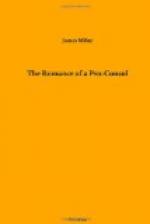‘I ascertained,’ he spoke of those efforts, ’that the soil was very suitable for wheat, and we sowed widely. The crop, vital to the Colony; depended upon the weather. Would there be enough rain? I often crawled out of bed in the morning, while it was half-dawn, to ascertain if there was any promise of rain for that day. The wheat was at the critical stage, and if I had made the weather, it could not have proved more suited in its conditions.
’It was the first extensive wheat crop of South Australia; the first harvest-home of the bunch of people, who had there been shaken on to the sea-beach. When the wheat had ripened, everybody—including, I am glad to say, the Governor—turned to the harvesting of it. Riots had threatened earlier, the result of the state of affairs in the Colony, and the measures which I deemed it necessary to introduce. As a precaution, I had some soldiers, about a hundred and fifty, I think, sent to me from New South Wales. That was a step on which I was entitled to congratulate myself. At the pruning hook, in getting in that harvest, they were of vast assistance, and not often have soldiers been more nobly occupied.’
Yet the pruning hook, which Sir George associated with the historic harvest, and with Ridley, an early Australian colonist, was hardly of the Scriptural pattern. It was a subtle machine, invented for a harvest where the wheat-ears were needed, not the straw. The former were chopped off, collected in a sort of trough; and the straw was burned for manure. Here was waste, only there was no avoiding it, and, moreover, the meaning of ‘waste’ is defined by circumstances. The South Australian soil was so fruitful that it only needed to be thrown seed. Sir George satisfied himself that it contained gypsum, such as belongs to the fertile parts of Egypt. Thus gypsum reared wheat, under the foot-print of the black man, who shod his spear in obsidian. Things that began before history, were meeting from very different sides. Nature extended one hand to the inflow of civilisation, another to the rude holding of it back. There was a point of contact in the adventure of a settler, Turner by name, whom Sir George Grey met near the Murray River. It fell out comedy, but might have been tragedy; and how often those two flirt with each other round a corner!
The fact, upon which the affair hinged, was that Turner wore a wig, no doubt for sufficient reason. He was making a journey across country, and with him were a few natives, guides and packmen. Perhaps his head grew hot; anyhow, at some stage he took a penknife from his pocket, and ran the blade under the edge of the wig. The native nearest to him, suspicious of witchcraft, stared at this act, terror written on every feature. With a deft lift of the knife, Turner had the wig clear of his head. The native stayed no longer to consider ‘Is this a sorcerer?’ He whipped off, to what he considered a safe distance. The innocent Turner followed his retreat with laughing eye, amused at the effect produced. For acknowledgment, a spear cracked through the satchel on his back, and wounded him slightly. His load had saved his life, and he warily resumed the wig.




